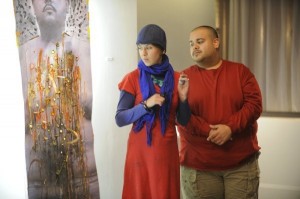In Episode 8 of Work of Art: The Next Great Artist, three artist pairs were selected at random, and given an assignment to jointly create works of art about opposing forces.
Peregrine Honig and Mark Velasquez worked on “Heaven and Hell,” Nicole Nadeau and Abdi Farah had “order and chaos,” and Miles Mendenhall and Jaclyn Santos were given “Male and Female.” With six artists left on the show vying for the grand prize of $100,000 and a solo show at the Brooklyn Museum of Art, the competitive energy in the studio was stronger than ever before.
Nicole/Abdi
Nicole and Abdi struggled with the theme of “order and chaos.” For his half of the project, Abdi tried to translate Socrates’ idea of the cave into a chaotic state. An unimpressive garble of green shapes sprawled over a yellow and red background, Abdi’s piece looked more like overgrown fungus than chaos. Abdi explained that one “leaves the cave and goes into chaos!”, which didn’t actually add anything to his argument.
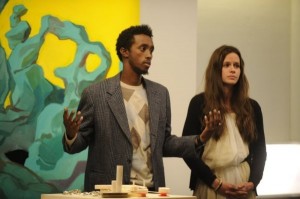
"Chaos/Order" by Abdi/Nicole on WORK OF ART: THE NEXT GREAT ARTIST (photo courtesy NBC Universal / Credit: Barbara Nitke)
Nicole paired here piece, Order, with Abdi’s Chaos. During the art-making process, Nicole said “I have a certain level of craft that has run through my veins,” which I read as a quietly creative statement about her confidence in her work. Order, she suggests, reflects “social order,” and the idea of “running this with different thoughts within a system, there is always an upper hand.” Within the constraints of our capitalistic American culture, there is an order and a clear system in place for us—for those who want to “succeed” based on the ideas set forth by capitalism, the trajectory is clear. “Wake up, go to work, get engaged, get married,” said Nicole. Her piece demonstrates this in a strong, clear way: Turning a circular wooden piece activates the tape with text about social norms on it that flows through the other six knobs of a pulley system. Each part depends on the functionality of the whole system that’s been set in place.
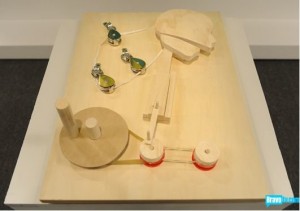
"Order" by Nicole Nadeau on WORK OF ART: THE NEXT GREAT ARTIST (photo courtesy NBC Universal / Credit: Barbara Nitke)
Jackie/Miles
In Jackie and Miles’ “Female/Male” pairing, Miles constructed a wall that he physically punched through, demonstrating aggressive act that suggested his masculine loss of control. He coated the wall with thick tar, which added a strikingly visceral quality to the piece. Jaclyn’s painting on femininity unfortunately perpetuated her own insecurities about the “male gaze” that she concurrently abhors and enjoys. Jaclyn fell back on an image of herself in a “private, sexualized act”: she stands upright in the bathroom and masturbates for the camera. When asked by judge Bill Powers what she was doing in the painting, Jaclyn smirked and chuckled.
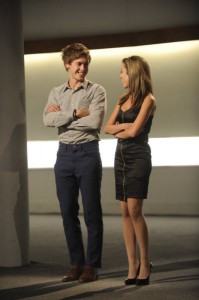
Miles and Jaclyn during final crits on WORK OF ART: THE NEXT GREAT ARTIST (photo courtesy NBC Universal / Credit: Barbara Nitke)
Peregrine/Mark
With the theme of “Heaven/Hell,” Mark immediately suggested that Peregrine take off her clothes. It was disappointing to see such an obvious move on Mark’s part, but the majority of Mark’s slick, unoriginal commercial photography relies on his sexist use of women. Scrolling through the portraits section of his website, one finds easy examples of this, like a sexualized image of a woman lying in the dirt, with dirt covering her body. His fashion photography portrays mostly near-nude women, the weakest images here being of a skinny muscular white woman wearing an American flag-patterned bikini and aviator sunglasses. In one image, standing behind a background of white siding, a woman pours water from an American flag-patterned cup onto her stomach; in another, shot against a brick background, she wears over-the-knee white vinyl boots, and holds two presumably fake machine guns up into the air while smiling and gritting her teeth.
These sorts of dull commercial images are merely reproductions the overused “hot, sexy American woman” one might picture on Girls Gone Wild. It is with this sort of simplicity that Mark approaches the project, suggesting that Peregrine take off her clothes and pose for him in simplistic portrayals of heaven and hell.
Peregrine first appeases his male ego, saying that if she had to be in a state of undress for the piece, she would be. But in a smart move—because she is clearly more intelligent and sees the impending catastrophe of Mark’s bland ideas—she suggests that he turn the camera on himself. Though he is extremely uncomfortable by the idea—even though he seems to have no problem bringing Peregrine into such a state—Mark complies. Then he spends the rest of the episode acting as if he is both the victim and the martyr for this project. Peregrine attempted to bring his work out of the usual simplicity he is used to, not forcing him into a space that would make him feel ashamed and uncomfortable.
The two artists decide to tell the story of Mark’s giant stomach scar, which is a physical reminder of his survival. He received this scar when he was 18-years-old during operation on his stomach for internal stomach problems that the doctors said would kill him in 24 hours. In some sort of a “miracle” operation, Mark was saved. Peregrine attempted to turn this piece into the story of Mark’s scar, and the struggle between life and death, or heaven and hell. Mark was in figurative “hell” because of the pain; “heaven,” or his second chance at life, is suggested through the miracle of surgery. This duality is overly simplistic for such a complicated medical procedure like Mark’s diverticulitis operation, which he didn’t explain at all. Acute diverticulitis is treated with antibiotics, but a severe case like Mark’s necessitates a portion of the colon be removed through surgery. Mark mentioned none of this, giving Peregrine only the visual image of the scar with. Mark, too involved with his own ideas of portraying himself as a saint, none too surprisingly portrays himself as a glowing figure in “heaven.” In the image, a flash of lightning covers his scar, and light appears above the crown of his head. His body disappears below the waist, yet the glossy white piece of paper continues, leaving a red carpet-like trail on the floor. In Peregrine’s portion of the work, Hell, the state she seems to be in throughout this challenge, she attempts to portray the internal pain that Mark feels because of the stomach pain. He doesn’t give her much to work with. She scratches the image of his chest with red, orange and yellow glitter that drips down onto his crotch. His eyes become blazing gold circles. Black dots surround his head. She finds used cigarette butts on the streets of New York City and shoves them into his image.
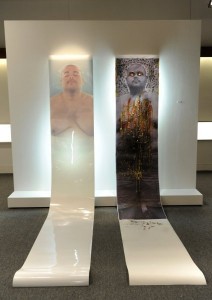
"Heaven/Hell" by Mark/Peregrine on WORK OF ART: THE NEXT GREAT ARTIST (photo courtesy NBC Universal / Credit: Barbara Nitke)
Mark’s work on this show has been consistently weak, yet he managed to slip through the judges’ critiques precisely because mediocrity is safe. Trying something new, being vulnerable, and even just being honest is not only scary, it’s dangerous because one might see things they otherwise would just ignore, and then have to deal with them. Mark’s only successful piece on Work of Art occurred in the first episode, when he drew a portrait of fellow contestant, Erik. Throughout the series, Mark has commented on how amazing Erik is as an artist, which makes sense—they are both mostly self-taught, though Erik didn’t go to art school—and they both flex their macho arrogance at any given chance.
After the episode 8 ended, Mark posted on his Facebook profile the portrait that he would have made if Peregrine hadn’t made a much-needed suggestion to this project.
At first glance, this looks like a portrait of a beautiful nude young boy, flying upwards toward the light. Apparently this is not a young boy—instead it is a portrait of Mark’s 18-year-old friend, Jenna, who was diagnosed with Lyme disease at an early age. The image also looks like it could have been nude Peregrine.
Mark’s images of men, or women who look like young boys, appear far more honest and sensitive than his redundant, sexist portrayals of women. Scroll through the portraits on Mark’s website and find this portrait of a large Latino man dressed in black, sitting at a checkered table drinking Coke in a glass. The man, who is either Mark or a closely related relative, looks back at the camera with a sensitivity not visible in the other portraits. For once there is something real in his eyes, not a staged attempt at “sexy” or “freak.” And in Mark’s portrait of Erik, there is an honesty that the hard-ass judges see. Bill Powers notes that Mark’s “portrait of Erik from the first challenge remains his best work from the series.” But this week, it was time for Mark to leave.

